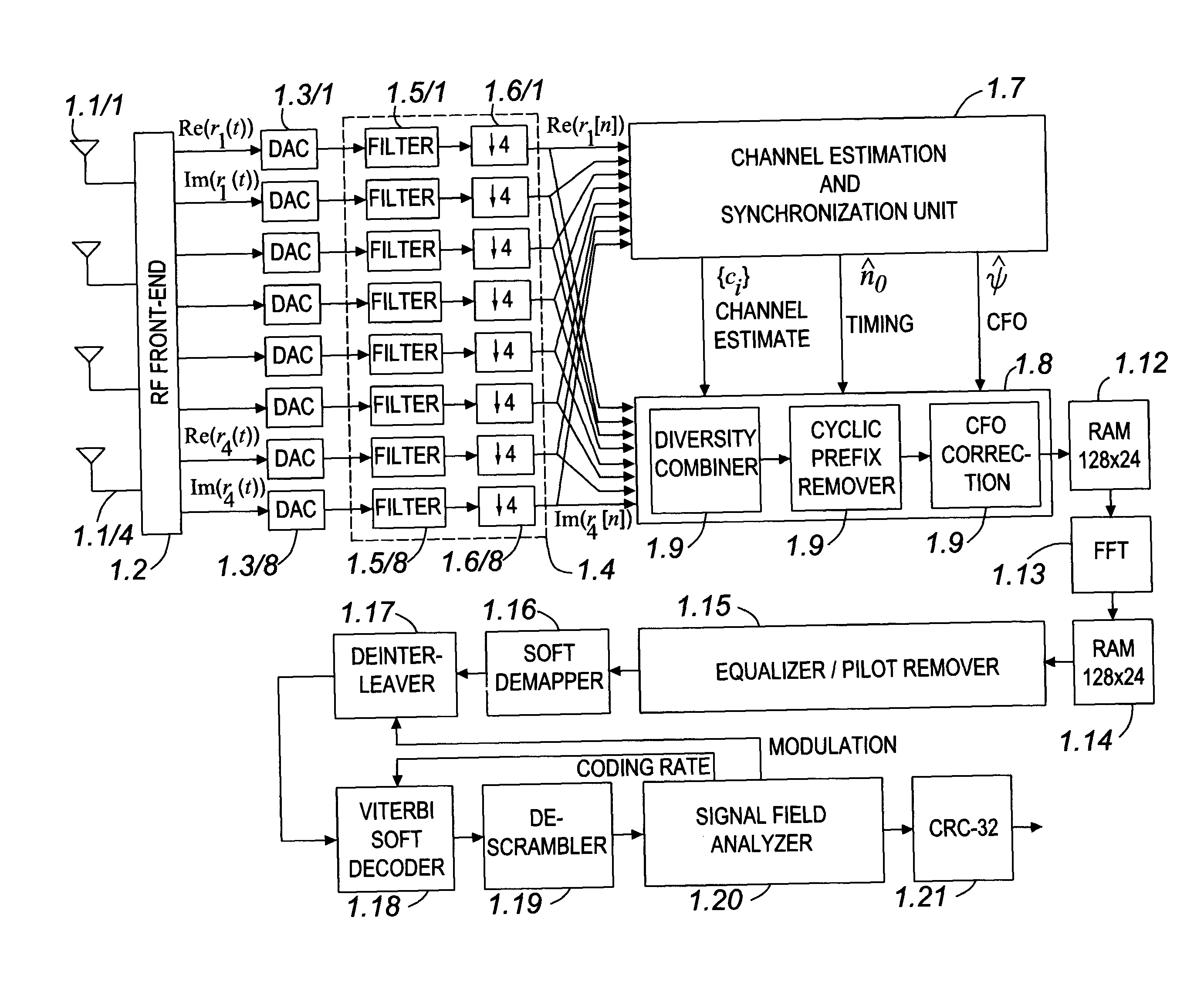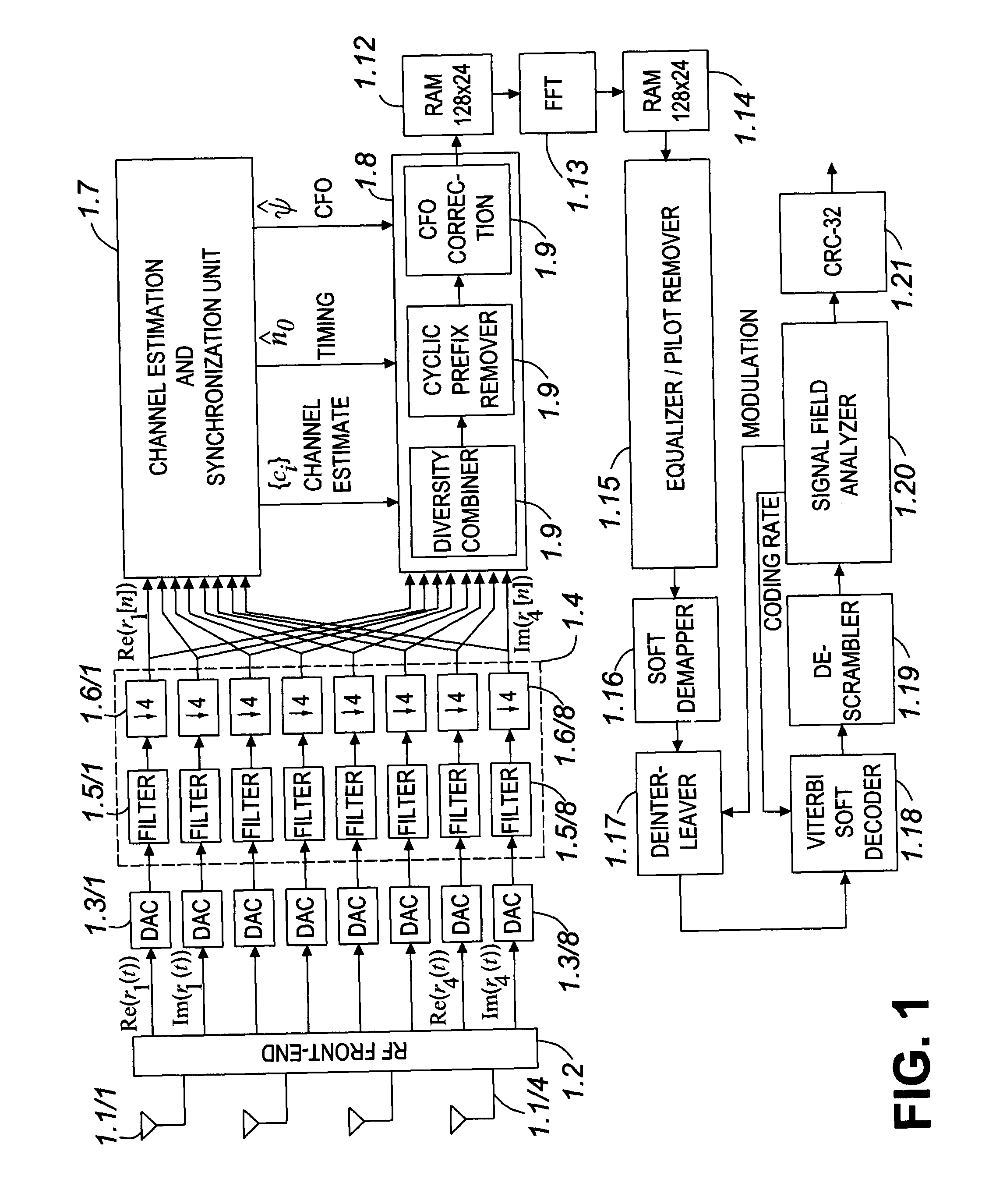Method and apparatus for signal acquisition in OFDM receivers
a receiver and orthogonal frequency division technology, applied in the direction of transmission systems, channel estimation, polarisation/directional diversity, etc., can solve the problems of multi-path fading, generated as the same signal, and many challenges of wireless communications, and perhaps the most problematic problems
- Summary
- Abstract
- Description
- Claims
- Application Information
AI Technical Summary
Problems solved by technology
Method used
Image
Examples
first preferred embodiment
[0052]The configuration of a first preferred embodiment, namely an OFDM array receiver which performs, jointly, time synchronization, CFO estimation and channel estimation, will now be described with reference to FIG. 1, and its operation with reference to FIG. 5, specifically with regard to implementation of the signal acquisition functions required of an OFDM receiver.
[0053]FIG. 1 illustrates a type of OFDM receiver tailored to the reception of OFDM packets compliant with the IEEE 802.11 standard and featuring diversity combining exploiting an array antenna comprising 4 elements 1.1 / 1 through 1.1 / 4. Signals received on these antenna elements are processed firstly by an RF front-end (1,2) which, for each antenna element, performs standard receiver chain operations such as filtering, channel selection, and downconverting. The selected 20 MHz-wide channel is brought to baseband, so that the RF front-end must separately output inline (real) and quadrature (imaginary) components for ea...
second preferred embodiment
[0070]In the first preferred embodiment, step 5.8 supposes that the algorithm is applied on a given time window within which the receiver has knowledge that one and exactly one frame has been transmitted. In other words, some sort of previous coarse timing estimate is assumed.
[0071]It may be desirable, in practice, to rely on a threshold mechanism to detect the presence of a frame before searching for a maximum within a specified time window, Such threshold and window values are presented here in the context of a second preferred embodiment which uses the basic hardware filter structure shown in FIG. 6, but with some hardware improvements as shown in FIG. 7, and operation differently, as illustrated by the different flow chart shown in FIG. 8.
[0072]As depicted by FIG. 7, a second structure is used to compute the average power on the N received signals over the last 160 samples (being the length of the equivalent filter corresponding to the structure depicted by FIG. 6). As is the ca...
third preferred embodiment
[0078]As the RMS delay spread of the channel increases, the PER increases since less energy is received through the channel associated with the narrow-band channel estimate. Indeed, as the length of the channel impulse response increases, the channel behavior becomes more frequency-selective, making the narrow-band channel estimate less suitable for space-time processing. Over a highly spreading channel, a third embodiment of the present invention can provide a wideband channel estimate. Indeed, through linearity, the main impulse is closely matched to the channel impulse response.
[0079]The channel estimate becomes less reliable as samples are taken farther away from the peak of the impulse response due to both the Dirac delta function approximation as well as to the deteriorating immunity to Gaussian noise as the magnitude of the channel estimation decreases. As a result, the length of the channel impulse response is considered to be a few samples long providing a reliable channel ...
PUM
 Login to View More
Login to View More Abstract
Description
Claims
Application Information
 Login to View More
Login to View More - R&D
- Intellectual Property
- Life Sciences
- Materials
- Tech Scout
- Unparalleled Data Quality
- Higher Quality Content
- 60% Fewer Hallucinations
Browse by: Latest US Patents, China's latest patents, Technical Efficacy Thesaurus, Application Domain, Technology Topic, Popular Technical Reports.
© 2025 PatSnap. All rights reserved.Legal|Privacy policy|Modern Slavery Act Transparency Statement|Sitemap|About US| Contact US: help@patsnap.com



